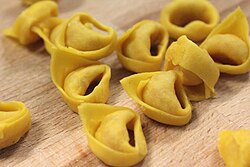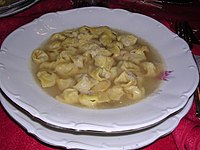
Pasta is a type of food typically made from an unleavened dough of wheat flour mixed with water or eggs, and formed into sheets or other shapes, then cooked by boiling or baking. Pasta was traditionally only made with durum, although the definition has been expanded to include alternatives for a gluten-free diet, such as rice flour, or legumes such as beans or lentils. While Asian noodles are believed to have originated in China, pasta is believed to have independently originated in Italy and is a staple food of Italian cuisine, with evidence of Etruscans making pasta as early as 400 BCE in Italy.

Lasagna, also known as lasagne, is a type of pasta, possibly one of the oldest types, made in very wide, flat sheets. The same-named Italian dish is made of stacked layers of lasagna alternating with fillings such as ragù, béchamel sauce, vegetables, cheeses, and seasonings and spices. The dish may be topped with grated cheese, which becomes melted during baking. Typically cooked pasta is assembled with the other ingredients and then baked in an oven. The resulting baked pasta is cut into single-serving square or rectangular portions.

Spätzle ( ), or nokedli in Hungarian, are a type of Central European egg noodles typically served as a side for meat dishes with sauce. Commonly associated with Swabia and Alsace, it is also found in the cuisines of southern Germany and Austria, Switzerland, Liechtenstein, Hungary, Vojvodina, Slovenia, Lorraine, Moselle, and South Tyrol.

Tagliatelle are a traditional type of pasta from the Italian regions of Emilia-Romagna and Marche. Individual pieces of tagliatelle are long, flat ribbons that are similar in shape to fettuccine and are traditionally about 6 mm wide. Tagliatelle can be served with a variety of sauces, though the classic is a meat sauce or Bolognese sauce.
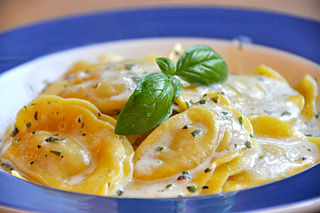
Ravioli are a type of stuffed pasta comprising a filling enveloped in thin pasta dough. Usually served in broth or with a sauce, they originated as a traditional food in Italian cuisine. Ravioli are commonly square, though other forms are also used, including circular and semi-circular (mezzelune).

Pelmeni are dumplings of Russian cuisine that consist of a filling wrapped in thin, unleavened dough.

Kreplach are small dumplings in Ashkenazi Jewish cuisine filled with ground meat, mashed potatoes or another filling, usually boiled and served in chicken soup, though they may also be served fried. They are similar to Polish pierogi, Polish and Ukrainian uszka, Russian pelmeni, Italian ravioli or tortellini, German Maultaschen, and Chinese jiaozi and wonton. The dough is traditionally made of flour, water and eggs, kneaded and rolled out thin. Some modern-day cooks use frozen dough sheets or wonton wrappers. Ready-made kreplach are also sold in the kosher freezer section of supermarkets.

Tortelloni is a type of stuffed pasta common in northern Italy, with a shape similar to tortellini, but larger and with a cheese-based filling. It is traditionally stuffed with ricotta, Parmesan, leafy herbs or vegetables such as parsley or spinach, egg and nutmeg.
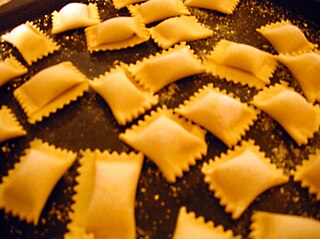
Agnolotti is a type of stuffed pasta typical of the Piedmont region of Italy, made with small pieces of flattened dough folded over a filling of roasted meat or vegetables. Agnolotti can be di magro or di grasso depending on their filling of vegetables or meat.
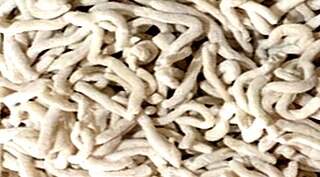
Strozzapreti are an elongated form of cavatelli, or hand-rolled pasta typical of the Emilia-Romagna, Tuscany, Marche and Umbria regions of Italy as well as in the state of San Marino. The name is also used for a baked cheese and vegetable dumpling, prepared in some regions of Italy and on the French island of Corsica.

Bolognese sauce, known in Italian as ragù alla bolognese or ragù bolognese, is a meat-based sauce in Italian cuisine, typical of the city of Bologna. It is customarily used to dress tagliatelle al ragù and to prepare lasagne alla bolognese.

Tortelli is a type of stuffed pasta traditionally made in the Lombardy, Emilia-Romagna and Tuscany regions of Italy. It can be found in several shapes, including square, semi-circular or twisted into a rounded, hat-like form. It can be served with melted butter, bolognese sauce, broth or other sauces. The same word is also used to describe small, fried pastries filled with jam or cream.

Dumpling is a broad class of dishes that consist of pieces of cooked dough, often wrapped around a filling. The dough can be based on bread, wheat or other flours, or potatoes, and it may be filled with meat, fish, tofu, cheese, vegetables, or a combination. Dumplings may be prepared using a variety of cooking methods and are found in many world cuisines.
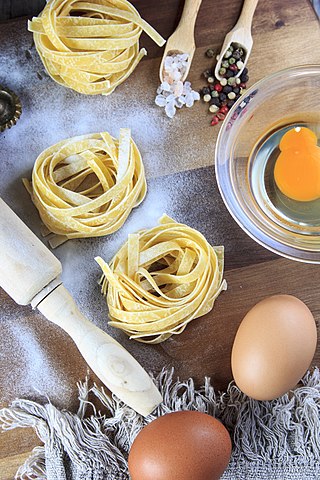
Sfoglina, Sfoglino is someone who makes sfoglia, a form of Italian fresh pasta which resembles a sheet. A sfoglina is historically seen as a middle-aged woman who rolls and stretches out the dough with a rolling pin called a mattarello, on a large wooden pastry board called a taglieri. Their typical handmade creations are tagliatelle, tortellini and other egg-pasta, also many times stuffed pasta like tortelloni or cappeletti.
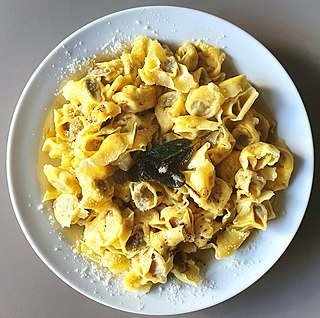
Agnolini are a type of egg-based stuffed pasta originating in the province of Mantua, Italy. it is often eaten in soup or broth.

Cappelletti are ring-shaped stuffed pasta so called for the characteristic shape that resembles a hat. Compared to tortellini, they have a different shape, larger size, thicker dough and different filling.
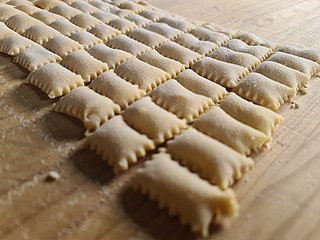
Spoja lorda or stuffed soup is a type of filled egg pasta with a square shape, similar to ravioli. It is typical of Romagna, particularly in the province of Ravenna and Faenza, where it is traditionally served in broth as a first course on holidays. The name spoja lorda derives from the use of the leftover dough from the preparation of cappelletti or, alternatively, from a dialectal expression used to describe a dough with scant filling and, therefore, just "dirty".
